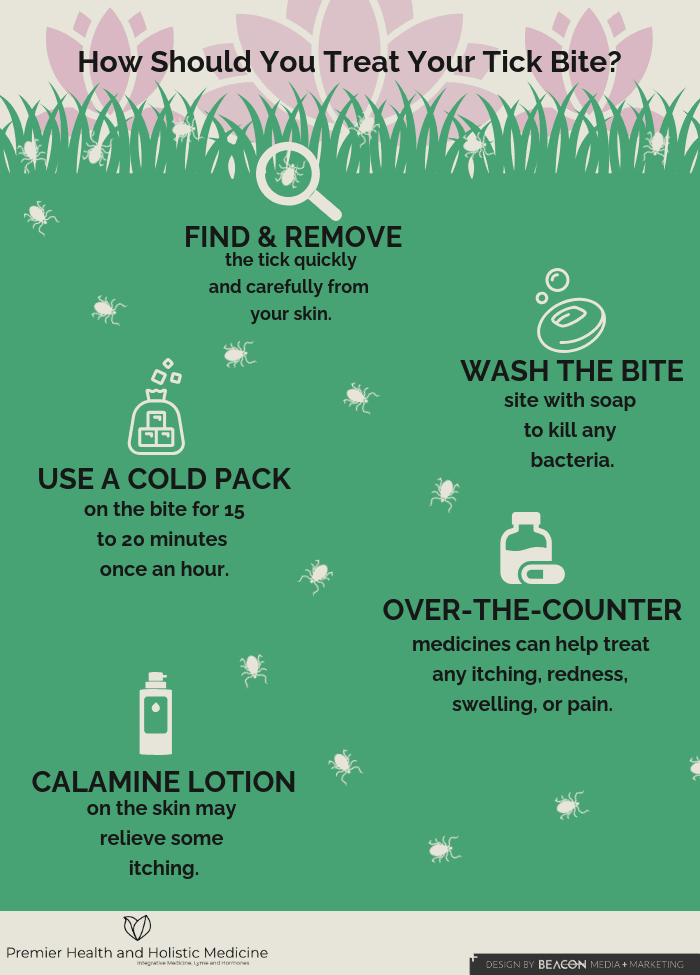Many people worry about their beloved dogs and cats getting tick bites. However, it’s not as commonly talked about for humans. We know that our dogs should have tick prevention measures and understand how to treat them, but people should take similar precautions when visiting areas ticks are common.
As the warmer seasons come around, you are also at risk for tick bites. Even as you’re enjoying your fun day in the sun, ticks won’t stop from biting you.
So, how should you treat a tick bite? If you’ve noticed a bullseye rash on your skin or even a tick that is still attached, then you’ll need to know how to treat it. Here are some steps to preventing Lyme disease and how you should treat your tick bite.
Have you noticed a bullseye rash on your skin? Schedule an appointment with Premier Health and Holistic Medicine today to get help.
How Can You Get a Tick Bite?
Ticks are around all year round. However, more people tend to go outside and enjoy the sun once spring comes around.
When you’re outside enjoying your favorite activities such as camping, hiking, and golfing, ensure that you take prevention steps to avoid tick bites. Ticks love being in grassy or bushy areas, which is the most common stop for them to crawl onto you.
Ticks can’t jump or fly, so they rely on tall bushes and grass blades to latch onto their meal. They will use their hind legs to keep themselves firmly attached to the vegetation and stretch their front legs out in hopes of grabbing onto something that passes by.
When you walk past them, they will crawl onto your clothes then move around until they can find a comfortable place to latch onto your skin. They primarily attach themselves in hard-to-see places, making it harder for you to spot them.
The tick will then bite onto you and begin its prolonged feeding preparation that can take anywhere from 10 minutes to 2 hours. Some ticks are equipped with ways to make it hard for you to detach them, such as barbed feeding tubes and anesthetic saliva that make it hard for you to feel them biting you.
Ticks will stay attached until they have finished their feeding, which can last up to 48 hours. So, the quicker you can spot and detach them, the lower likelihood that you’ll contract Lyme disease.
What Prevention Measure Can You Take To Avoid a Tick Bite?
Although staying indoors would be a great way to prevent tick bites, you can’t be expected to stay inside forever. There is a way to enjoy all your favorite outdoor activities while staying aware of tick bite prevention measures.
- Avoid Dense Vegetation: Since ticks like hanging out in grassy and bushy areas, it’s good to avoid traveling through those areas. If you’re hiking, go along the cleared path where ticks are less likely to be.
- Wear Protective Clothing: If you can’t avoid dense pockets of vegetation, then you should wear protective clothing treated with 0.5% permethrin. You can also treat your clothes with permethrin, and it will stay for several washes.
- Spray Insect Repellent: Using Environmental Protection Agency (EPA)- registered insect repellents can ward off ticks. However, be aware that some may contain OLE or PMD that should not be used on children under three years old.
- Clean Your Pets: A way to ensure ticks don’t invade your home is by checking your pets in hard-to-see areas whenever they return inside. You can also treat your dogs with tick prevention methods.
- Landscape Your Yard: Regularly landscaping your yard is a great preventative measure for ensuring that you, your child, or your pets don’t run into ticks. You can mow your lawn and fortify your home against ticks.
Do you think you’ve been bitten by a tick? Schedule an appointment with us today to seek help.
How Can You Prevent Lyme Disease?
The earlier you can detect ticks, the greater your chances of preventing Lyme disease. Since ticks like to hide in hard-to-see places, you should shower within two hours of returning inside. You should also make sure to check these areas:
- In and around the ears
- In and around the hair
- Inside belly button
- Around the waist
- Under the arms
- Back of the knees
- Between the legs
Ticks can transmit Lyme disease when they feed on an animal with a bloodborne illness containing the bacterium Borrelia burgdorferi. Then when ticks bite you, they can spread the disease, and you can get Lyme disease. Currently, there is no evidence to show that humans can transmit the disease to one another and that your pets can spread it to you.
In general, ticks have to be attached for 36 to 48 hours before the Lyme disease bacterium is transmitted to you. Ensure that you are thoroughly checking your body for ticks, as some can be less than 2 mm small.
How Should You Treat Your Tick Bite?

The first step is to remove the tick quickly and carefully from your skin. Remember that some ticks have barbed feeding tubes that are meant to make it difficult to detach. So, make sure that you’re removing the tick as carefully as possible to prevent further damage to your skin.
Then you should wash the bite site with soap to kill any bacteria that may have been transferred. You can continue to thoroughly clean the bite as it heals. Some other home care tips include:
- Use a cold pack on the bite for 15 to 20 minutes once an hour.
- Utilize over-the-counter medicines to treat any itching, redness, swelling, or pain.
- Put calamine lotion on the skin may relieve some itching.
If you notice that you have flu-like symptoms over the coming days, including fever, chills, body aches, headaches, or fatigue, you should consult your doctor. If you’re unsure that a tick has bitten you, a typical bullseye rash can appear on your skin. However, don’t use this as a telling sign, as some never get a rash.
What Should You Do If You Think You’ve Contracted Lyme Disease?
Lyme disease can be commonly misdiagnosed as the flu since they share many symptoms in the early stages of the disease. However, if your symptoms have prolonged over the typical five to seven days of the flu, you could have Lyme disease.
It would be best to get tested by your physician for Lyme disease before the later stages take effect. On top of the early-stage symptoms, you may experience a multitude of later-stage symptoms, including:
- Heart palpitations
- Dizziness
- Nerve pain
- Chronic fatigue
- Numbness in hands or feet
- Facial palsy
Why Should You Get Treated at Premier Health and Holistic Medicine?
At Premier Health and Holistic Medicine, you can get treated for Lyme disease by Dr. Robin Ridinger. She takes a holistic approach to Lyme disease treatment. While analyzing all your body symptoms and how they interact, she’ll come up with the best treatment plan for you.
Dr. Ridinger emphasizes a personalized treatment that will fit all of your needs. Your holistic Lyme disease treatment can include:
- Detoxification
- Diet and supplements
- Thyroid replacement therapy
- Adrenal support
- Bioidentical hormones
- Herbal therapies
- Antibiotics or antifungals, if needed
Although Dr. Ridiner prefers a holistic approach to curing Lyme disease, she will do what is best for you. She may prescribe antibiotics or antifungals to prevent late-stage Lyme disease. If you suspect that you’ve been bitten and are experiencing Lyme disease symptoms, you should seek medical attention.
Don’t let the ticks bring you down this summer season. Seek help from Premier Health and Holistic Medicine since it’s an excellent resource for your Lyme disease care in Leesburg, VA.
Are you ready to seek a holistic solution for your Lyme disease? Schedule an appointment with us today!


